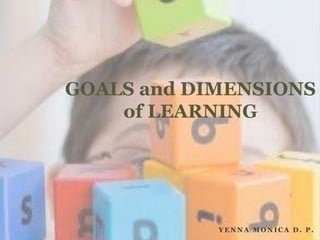
Goals and Dimensions of Learning
- 1. Y E N N A M O N I C A D . P . GOALS and DIMENSIONS of LEARNING
- 2. Dimensions of Learning (DoL) Is a comprehensive framework/model to help educators plan learning experiences for their students. It is based on extensive research about learning and how the mind works. It has been designed to help educators improve students’ learning through curriculum, instruction and assessment using five critical aspects of the learning process, or dimensions of learning.
- 3. How can Dimensions of Learning be used by Educators? The Goal of Education is to enhance learning for all students. Over the last 15 years, the McRel Group has conducted substantial research on teaching and learning, and how the brain functions. They have drawn this and other research in the development of 5 key dimensions, the Dimensions of Learning, that underpin good teaching In many schools the DoL framework has been embedded within curriculum development and classroom practice.
- 4. The Five Dimensions are as follows: DIMENSION 1: ATTITUDES AND PERCEPTIONS DIMENSION 2: ACQUIRE AND INTEGRATE NEW KNOWLEDGE DIMENSION 3: EXTEND AND REFINE KNOWLEDGE DIMENSION 4: USING KNOWLEDGE MEANINGFULLY DIMENSION 5: HABITS OF MIND
- 5. The Dimensions of Learning
- 6. DIMENSION 1: ATTITUDES and PERCEPTIONS The Attitudes of learners, their peers and teachers influence learning. Teachers need to help generate positive attitudes towards learning for all students - this requires constant monitoring of the classroom environment and student progress, adapting the program to build in success and positive learning experiences for all learners Classroom Climate - Feel accepted by teachers and peers - Experience a sense of comfort and order Classroom Tasks - Perceive tasks as valuable and interesting - Believe they have the ability and resources Understand and be clear
- 7. DIMENSION 2: ACQUIRE and INTEGRATE NEW KNOWLEDGE Focuses on ways to help students acquire and retain new knowledge. Learning requires both the acquisition of information and the ability to retrieve and reconstruct that information whenever necessary. Within Dimension 2, two different kinds of knowledge are identified: DECLARATIVE KNOWLEDGE - which includes facts, concepts and generalizations PROCEDURAL KNOWLEDGE - which includes skills and processes
- 8. DECLARATIVE KNOWLEDGE PROCEDURAL KNOWLEDGE Construct Meaning Link new information to prior knowledge; Descriptions time sequences cause effect episodes Generalizations concepts similarities Differences 3-minute pause Construct Model demonstrations and modeling: construct steps, think aloud, graphic representation, similarities, differences, mentally rehearse Shape provide feedback and refine process: narrative, practice variations, identify common errors, integrate knowledge and skill Internalize Practice and use, practice schedule, chart and report, establish connectedness and relevance DIMENSION 2: ACQUIRE and INTEGRATE NEW KNOWLEDGE Acquire and Integrate Knowledge Identify patterns in information: Graphic organizers, advance organizers, note taking strategies, graphs and charts Internalize/Store Knowledge Consciously store information in memory: Symbols, substitutes, links, structures systems, mnemonics
- 9. DIMENSION 3: EXTEND and REFINE KNOWLEDGE Once new knowledge has been acquired and integrated, students need to develop in- depth understanding by extending and refining their knowledge. Transforming the knowledge into another form, for example metaphoric expression through visual arts, theatre/ drama or poetry. There are eight complex reasoning processes in this dimension: Comparing Abstracting Analyzing Errors Deductive Reasoning Classifying Constructing Support Analyzing Perspectives Inductive Reasoning
- 10. SOME COMPLEX REASONING PROCESSES of DIMENSION 3 Comparing – The process of identifying and articulating similarities and differences among items. Classifying – The process of grouping things into definable categories on the basis of their attributes. Analyzing Errors – is the study of kind and quantity of error that occurs particularly in the fields of applied mathematics (particularly numerical analysis) Deductive Reasoning – “top down logic” is the process of reasoning from one or more general statements (premises) to reach from general statement. Inductive Reasoning – the conclusion is reached from specific examples.
- 11. DIMENSION 4: USE KNOWLEDGE MEANINGFULLY Learners will internalize knowledge more effectively when they are able to use it to perform a meaningful task, this is particularly pertinent for assessment. Meaningful (or Authentic) tasks are those that use real life or life-like contexts for students to demonstrate their knowledge and skills within. Six Reasoning Processes are identified in this dimension: Decision making Invention Experimental Inquiry Problem Solving Investigation System Analysis
- 12. SIX REASONING PROCESSES OF DIMENSION 4 Decision Making – process of answering questions as “What is the best way to?” “Which of these is most suitable?” Problem Solving – refers to a state of desire for reaching a definite goal. Investigation – a way of knowledge that is similar to experimental inquiry. Experimental Inquiry – problem solving that is governed by rules of process and evidence. The most well-known type of experimental inquiry is the “Scientific Method” System Analysis – is the study of sets of interacting
- 13. DIMENSION 5: HABITS of MIND Habits of Mind are the kinds of productive mental habits that successful learners utilize. A habit of mind having a disposition toward behaving intelligently when confronted with problem, the answers to which are not immediately known. Within the original Dimensions of Learning framework, 3 major organizers were identified for HoM and these are: Critical Thinking Creative Thinking and Self – Regulated Thinking
- 14. MAJOR ORGANIZERS for HABITS of MIND Critical Thinking – way of deciding whether a claim is true, sometimes true, partly true, or false. It is an important component of most professions. It is part of formal education and is increasingly significant as students progress through university to graduate education. Self – Regulated thinking – Describes a process of taking control of and evaluating one’s own learning and behavior.
- 15. GOALS and DIMENSIONS of LEARNING The Relationship Between the Five Dimensions of Learning A student’s attitudes and perceptions (Dimension 1) and productive habits of mind (Dimension 5) are the foundations for acquiring, integrating, extending and refining and applying knowledge. (Dimensions 2, 3, 4)
- 16. GOALS and DIMENSIONS of LEARNING END Thank You!!!! ^^
